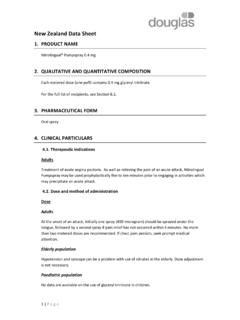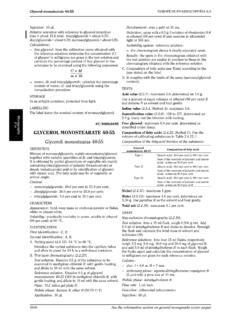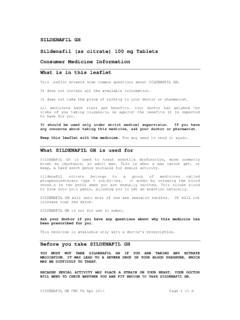Transcription of Appendix (i) The ‘ABCDE’ approach to the sick patient
1 STANDARDS FOR CLINICAL PRACTICE AND TRAINING FOR DENTAL PRACTITIONERS AND DENTAL CARE PROFESSIONALS IN GENERAL DENTAL PRACTICE 21 MEDICAL EMERGENCIES AND RESUSCITATION Appendix (i) The abcde approach to the sick patient This Appendix and the one following provide guidance on the initial approach and management of common medical emergencies which may arise in general dental practice. Dental Practitioners, Dental Care Professionals and their staff should be familiar with standard resuscitation procedures as recommended by the Resuscitation Council (UK). In all circumstances it is advisable to call for medical assistance as soon as possible by dialing 999 and summoning an ambulance. Early recognition of the sick patient is to be encouraged. Pre-empting any medical emergency by recognising an abnormal breathing pattern, an abnormal patient colour or abnormal pulse rate, allows appropriate help to be summoned , ambulance, prior to any patient collapse occurring.
2 A systematic approach to recognising the acutely ill patient based on the abcde principles is recommended. Accurate documentation of the patient s medical history should further allow those at risk of certain medical emergencies to be identified in advance of any proposed treatment. The elective nature of most dental practice allows time for discussion of medical problems with the patient s general medical practitioner where necessary. In certain circumstances this may lead to a postponement of the treatment indicated or a recommendation that such treatment be undertaken in hospital. General principles 1. Follow the Airway, Breathing, Circulation, Disability, and Exposure approach ( abcde ) to assess and treat the patient . 2. Treat life-threatening problems as they are identified before moving to the next part of the assessment.
3 3. Continually re-assess starting with Airway if there is further deterioration. 4. Assess the effects of any treatment given. 5. Recognise when you need extra help and call for help early. This may mean dialling 999 for an ambulance. 6. Use all members of your dental team. This will allow you to do several things at once, , collect emergency drugs and equipment, dial 999. 7. Organise your team and communicate effectively. 8. The aims of initial treatment are to keep the patient alive, achieve some clinical improvement and buy time for further treatment whilst waiting for help. 9. Remember - it can take a few minutes for treatment to work. 10. The abcde approach can be used irrespective of your training and experience in clinical assessment or treatment. Individual experience and STANDARDS FOR CLINICAL PRACTICE AND TRAINING FOR DENTAL PRACTITIONERS AND DENTAL CARE PROFESSIONALS IN GENERAL DENTAL PRACTICE 22 MEDICAL EMERGENCIES AND RESUSCITATIONAPPENDIX (i) training will determine which treatments you can give.
4 Often only simple measures such as laying the patient down or giving oxygen are needed. First steps In an emergency, stay calm. Ensure that you and your staff are safe. Look at the patient generally to see if they look unwell . In an awake patient ask, How are you? If the patient is unresponsive, shake him and ask, Are you all right? If they respond normally, they have a clear airway, are breathing and have brain perfusion. If they speak only in short sentences, they may have breathing problems. Failure of the patient to respond suggests that they are unwell. If they are not breathing and have no pulse or signs of life, start CPR according to current resuscitation guidelines. Airway (A) Airway obstruction is an emergency. 1. Look for the signs of airway obstruction: Airway obstruction causes paradoxical chest and abdominal movements ( see-saw respirations) and the use of the accessory muscles of respiration , neck muscles.
5 Central cyanosis (blue lips and tongue) is a late sign of airway obstruction. In complete airway obstruction, there are no breath sounds at the mouth or nose. In partial airway obstruction, air entry is diminished and usually noisy - Inspiratory stridor is caused by obstruction at the laryngeal level or above. - Expiratory wheeze suggests obstruction of the lower airways, which tend to collapse and obstruct during expiration. This is most commonly seen in patients with asthma or chronic obstructive pulmonary disease. - Gurgling suggests there is liquid or semi-solid foreign material in the upper airway. - Snoring arises when the pharynx is partially occluded by the tongue or palate. 2. Airway obstruction is an emergency: In most cases, only simple methods of airway clearance are needed - Airway opening manoeuvres head tilt/ chin lift or jaw thrust.
6 - Remove visible foreign bodies, debris or blood from the airway (use suction or forceps as necessary). - Consider simple airway adjuncts , oropharyngeal airway. 3. Give oxygen initially at a high inspired concentration: Use a mask with an oxygen reservoir. Ensure that the oxygen flow is sufficient (15 litres per minute) to prevent collapse of the reservoir during inspiration. STANDARDS FOR CLINICAL PRACTICE AND TRAINING FOR DENTAL PRACTITIONERS AND DENTAL CARE PROFESSIONALS IN GENERAL DENTAL PRACTICE 23 MEDICAL EMERGENCIES AND RESUSCITATION If you have a pulse oximeter, titrate the oxygen delivery aiming for normal oxygen saturation levels (94-98%). In very sick patients this may not be possible and a lower oxygen saturation (more than 90%) is acceptable for a short period of time.
7 Breathing (B) During the immediate assessment of breathing, it is vital to diagnose and treat immediately life-threatening breathing problems, , acute severe asthma. 1. Look, listen and feel for the general signs of respiratory distress: sweating, central cyanosis (blue lips and tongue), use of the accessory muscles of respiration (muscles of the neck) and abdominal breathing. 2. Count the respiratory rate. The normal adult rate is 12 to 20 breaths per minute and a child s rate is between 20 and 30 breaths per minute. A high, or increasing, respiratory rate is a marker of illness and a warning that the patient may deteriorate and further medical help is needed. 3. Assess the depth of each breath, the pattern (rhythm) of respiration and whether chest expansion is equal and normal on both sides.
8 4. Listen to the patient s breath sounds a short distance from their face. Gurgling airway noises indicate airway secretions, usually because the patient cannot cough or take a deep breath. Stridor or wheeze suggests partial, but important, airway obstruction. 5. If the patient s depth or rate of breathing is inadequate, or you cannot detect any breathing, use bag and mask (if trained) or pocket mask ventilation with supplemental oxygen while calling urgently for an ambulance. 6. Hyperventilation and panic attacks are relatively common in general dental practice. In most patients these will resolve with simple reassurance. Circulation (C) Simple faints or vasovagal episodes are the most likely cause of circulation problems in general dental practice. These will usually respond to laying the patient flat and if necessary raising the legs (see Appendix (ii) Syncope).
9 The systematic abcde approach to all patients will ensure that other causes are not missed. 1. Look at the colour of the hands and fingers: are they blue, pink, pale or mottled? 2. Assess the limb temperature by feeling the patient s hands: are they cool or warm? STANDARDS FOR CLINICAL PRACTICE AND TRAINING FOR DENTAL PRACTITIONERS AND DENTAL CARE PROFESSIONALS IN GENERAL DENTAL PRACTICE 24 MEDICAL EMERGENCIES AND RESUSCITATIONAPPENDIX (i) 3. Measure the capillary refill time. Apply cutaneous pressure for five seconds on a fingertip held at heart level (or just above) with enough pressure to cause blanching. Time how long it takes for the skin to return to the colour of the surrounding skin after releasing the pressure. The normal refill time is less than two seconds. A prolonged time suggests poor peripheral perfusion.
10 Other factors ( , cold surroundings, old age) can also prolong the capillary refill time. 4. Count the patient s pulse rate. It may be easier to feel a central pulse ( , carotid pulse) than the radial pulse. 5. Weak pulses in a patient with a decreased conscious level and slow capillary refill time suggest a low blood pressure. Laying the patient down and raising the legs may be helpful. In patients who do not respond to simple measures urgent help is needed and an ambulance should be summoned. 6. Cardiac chest pain typically presents as a heaviness, tightness or indigestion-like discomfort in the chest. The pain or discomfort often radiates into the neck or throat, into one or both arms (more commonly the left) and into the back or stomach area. Some patients experience the discomfort in one of these areas more than in the chest.




